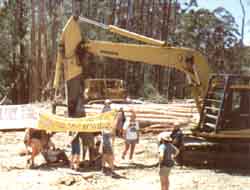|
The Otway Rainforest are
Dying and Logging is Spreading Disease
Old growth rainforests in the Otways are dying. An epidemic known
as Myrtle Wilt is steadily destroying the old growth stands of cool
temperate rainforest throughout the Otways.
Myrtle Wilt threatens remaining rainforests
This disease occurs naturally, however, it appears that clearfelling
and roading is aggravating the problem.
Senior management within the Department of Natural Resources
and Environment (DNRE) are aware of this problem, and have put
the interests of the wooding chipping industry ahead of the Otway
rainforests.
If urgent measures are not taken in the near future, the Otways
will loose most if not all, of the its precious remaining old
growth rainforests.
Disease description
A fungus (Chalara australia) enters a Myrtle Beech tree (Nothofagus
cunninghamii) through an exposed flesh wound.
Flesh wounds are normally caused during a storm when tree limbs
are broken off. The fungus grows through the tree vascular system
(the part of the tree that carries the sap), choking of the flow
of water to the tree crown and killing the tree. As the wood of
the tree dies, pin hole borer beetles (Platypus subgranosus)
bore into the timber and lay eggs.
After the eggs hatch, larvae bore through the tree. When the
larvae pupate, they drill out of the tree and fly off into the
forest to find another dying tree infected by the fungus. It is
likely that the wood dust produced by the boring beetle becomes
airborne and helps spread the fungus throughout the forest. It
can take up to three years from the time of infection for the
tree to die.
Visual Signs of Infection
- The first visible signs of disease is the wilting of foliage
throughout the crown of the tree (hence the Myrtle Wilt). The
foliage then becomes bright orange like autumn leaves.
- By the next season the leaves become a pale straw colour
and then fall.
- Around the base of infected trees can be seen a fine wood
dust where beetles have drilled their way in and out of the
tree.
The various symptoms of this disease can easily be seen throughout
the Otways including Maits Rest (located along the Great Ocean Road
near Apollo Bay in the Otway National Park), Melba Gully, Aire Crossing,
Triplet Falls and Turtons Track.
The Impact of Logging
Scientific studies done in Tasmania have demonstrated that the use
of heavy machinery to build roads and clearfell forest is causing
an increase in the wounding of Beech trees, thereby lifting the
infection rate. A study on Myrtle Wilt done in Tasmania (Kile et
al 1989) has clearly observed increased mortality rates due to logging
activities.
A recent report titled "Rainforest in Victoria - a review of
the scientific basis of current and proposed protection measures"
(Burgman 1995) states:
"Because the disease is a wood pathogen and because forest harvesting
and roading activities result in many otherwise insubstantial
wounds to trees, it is reasonable to suggest that there should
be a causal relationship between (particularly) mechanical disturbance
activities and disease frequency, either within or among rainforest
stands. In Victoria, road construction, harvesting in mixed forest
stands, and wind throw in buffers have the potential to elevate
background wounding rate."
"Wounding and infection are natural processes, particularly
in mixed forests and ecotonal communities with eucalypt overstoreys
where branch fall must cause wounds. Cameron and Turner (1996)
suggest that back ground inoculation rates are sensitive to human
disturbance because fungal spores are wind spread. Thus if the
wounding rate throughout the landscape increases the amount of
inoculum in the environment will increase throughout the landscape
from a series of local point infections resulting in an accelerated
infection rate. This scenario is not unreasonable and deserves
the attention of a specific research project.".
DNRE are avoiding crucial action studies
A research project on Myrtle Wilt in Victoria by Cameron and Turner
(1996) was funded by the National Rainforest Conservation Program.
A Federal Government grant of $70,000 was made for research
into Myrtle Wilt in the Otways. After completion the report was
withheld for three years. Public access to the report was granted
only after conservationists took legal action.
Forest planners are still allowing logging to continue in sensitive
rainforest areas. Those areas include the Aire River Catchment,
which is north west of Apollo Bay and the Cumberland River Catchment,
which is north west of Lorne.
REFERENCES
Brugman, M.A. (1995), "Rainforests in Victoria - a review of
the scientific basis of current and proposed protection measures.",
Department of Conservation & Natural Resources. (Available from
DNRE Bookshop, 240 Victoria Parade Melbourne.
Cameron & Turner (1996) " Surveying and monitoring Myrtle Wilt
within Cool Temperate Rainforest in Victoria." Department of Conservation
& Natural Resources.
Kile, G.A., Packham, J.M., Elliott, H.J., (1989) "Myrtle Wilt
and its Possible Management in Association with Human Disturbance
of Rainforest in Tasmania", NZ j. Forest Science, 19:256-264.
What You Can Do!
The DNRE have failed to protect these forest. Only the general public
with help from the scientific research can save Otways old growth
forests.
- Visit the areas that have been affected by logging and Myrtle
Wilt.
- Be prepared for public demonstrations in areas being logged
near rainforests.
- Avoid products made with material from the clearfelling of
Otway forests such as Kimberly Clark Products like Kleenex Tissues
and Toilet Tissue or Wondersoft Toilet Tissues.
| 

